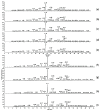Great Abilities of Shinella zoogloeoides Strain from a Landfarming Soil for Crude Oil Degradation and a Synergy Model for Alginate-Bead-Entrapped Consortium Efficiency
- PMID: 35889080
- PMCID: PMC9323222
- DOI: 10.3390/microorganisms10071361
Great Abilities of Shinella zoogloeoides Strain from a Landfarming Soil for Crude Oil Degradation and a Synergy Model for Alginate-Bead-Entrapped Consortium Efficiency
Abstract
Oil contamination is of great concern worldwide and needs to be properly addressed. The present work aimed to contribute to the development of bacterial consortia for oil recovery. We investigated the community structure of a landfarming-treated soil (LF2) by metagenomics to unravel the presence of hydrocarbon degraders. Moreover, we isolated Shinella zoogloeoides LFG9 and Bacillus swezeyi LFS15 from LF2 and combined them with Pseudomonas guguanensis SGPP2 isolated from an auto mechanic workshop soil to form the mixed consortium COG1. Bacterial isolates were tested for biosurfactant production. Additionally, the bioremediation potential of COG1 was studied as free and entrapped consortia by gas chromatography-mass spectrometry, in comparison to the single strains. Results revealed the presence of Actinobacteria (66.11%), Proteobacteria (32.21%), Gammaproteobacteria (5.39%), Actinomycetales (65.15%), Burkholderiales (13.92%), and Mycobacterium (32.22%) taxa, indicating the presence of hydrocarbon degraders in soil LF2. All three isolated strains were biosurfactant producers capable of degrading crude oil components within 14 days. However, Shinella zoogloeoides LFG9 performed best and was retained as candidate for further bioremediation investigation. In addition, COG1 performed better when immobilized, with entrapment effectiveness manifested by increased fatty acids and aromatic compound degradation. Attempt to improve crude oil biodegradation by adding surfactants failed as sodium dodecyl sulfate restrained the immobilized consortium performance.
Keywords: GC-MS; Shinella zoogloeoides; alginate bead entrapment; hydrocarbon bioremediation; metagenomics.
Conflict of interest statement
The authors declare no conflict of interest. The funders had no role in the design of the study; in the collection, analyses, or interpretation of data; in the writing of the manuscript, or in the decision to publish the results.
Figures






References
-
- Khandelwal A., Sugavanam R., Ramakrishnan B., Dutta A., Varghese E., Nain L., Banerjee T., Singh N. Free and Immobilized Microbial Culture–Mediated Crude Oil Degradation and Microbial Diversity Changes Through Taxonomic and Functional Markers in a Sandy Loam Soil. Front. Environ. Sci. 2022;9:794303. doi: 10.3389/fenvs.2021.794303. - DOI
-
- Zahed M.A., Matinvafa M.A., Azari A., Mohajeri L. Biosurfactant, a green and effective solution for bioremediation of petroleum hydrocarbons in the aquatic environment. Discov. Water. 2022;2:5. doi: 10.1007/s43832-022-00013-x. - DOI
-
- Alnuaimi M.T., Taher T.A., Aljanabi Z.Z., Adel M.M. High-resolution GC/MS study of biodegradation of crude oil by Bacillus megaterium. Res. Crops. 2020;21:650–657. doi: 10.31830/2348-7542.2020.101. - DOI
Grants and funding
LinkOut - more resources
Full Text Sources
Miscellaneous

